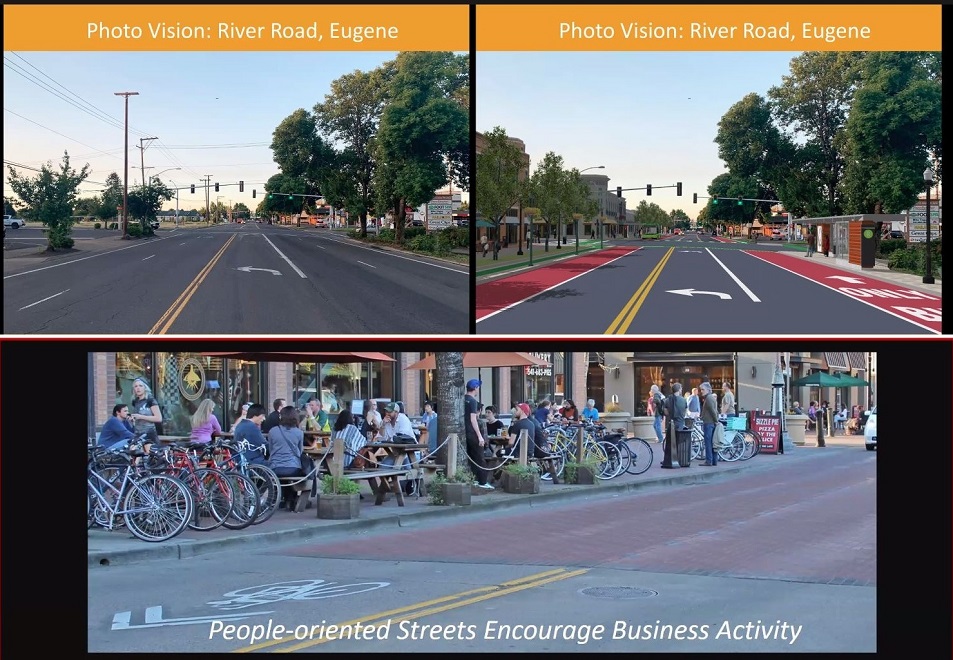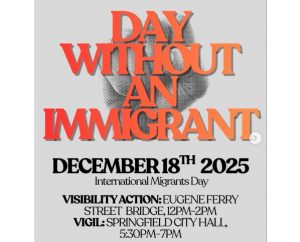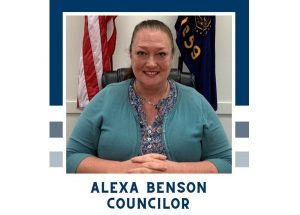Chamber hears that ‘good streets mean good business’
6 min read
Good streets mean good business, AARP policy analysts told the Eugene Springfield Chamber this week.
The Eugene Springfield Chamber sponsored a policy breakfast, “Good Streets Mean Good Business.” President and CEO of the Springfield Chamber, Vonnie Mikkelsen.
Vonnie Mikkelsen: [00:00:11] We have a number of projects underway in both Eugene and Springfield, and some of those major projects include the Franklin corridor; in Springfield, our Main Street project; and Eugene’s Moving Ahead project… It is important for us as the business community to understand how these significant investments work.
John Q: [00:00:30] From the AARP, Bill Armbruster.
Bill Armbruster: [00:00:33] When we talk about livability and age-friendly and all those things that go into a community, oftentimes the business community is not included in this discussion. So I think it’s just absolutely brilliant to have these discussions now and really talk about streets.
John Q: [00:00:51] Bill said when we talk about a street, we should talk about the experience.
Bill Armbruster: [00:00:56] When I come to the area where your businesses are, or where your downtown or your Main Street area, what’s the experience? Where you see people who are walking and cycling and you see a vibrant place, those also increase private property values and attract businesses as well. So really think about, what’s that experience?
I know personally, if I want to do something on the weekend, I will drive an hour or two or three hours to go into a town that has that great experience. They’ve got stores, they’ve got restaurants, they’ve got retail, and you can go in and you can spend a couple hours of walking because I have that unique experience and it is something that’s enjoyable to me. And if I lived closer, I would do that more on a regular basis. And I do the same thing near the city I live, I want to go to this part of town because, and it always comes down to walkability, to multiple things that’s accessible to me.
Thank you for supporting
local citizen journalism
John Q: [00:02:00] That experience can be measured, Bill said, with a walk score.
Bill Armbruster: [00:02:04] There’s something called a walk score and we see where there’s a ranking. This is how walkable your neighborhood or your community is. Walk scores that were higher, had 54% higher property values than areas that had scored lower in their walk scores.
And then one of the other things we saw, this is a report that came out of San Francisco and they were looking at travelers, either transit or walkers. They may not spend as much when they come into your establishment, but over a month, they make more trips and they spend more than that someone who’s coming in by car, because they have constant access to you on a regular basis.
So the overall spending of, for people who are getting out walking or using transit is actually higher than people who are driving.
John Q: [00:02:58] Robert Alan Ping, who spoke to the Chamber this week, also presented earlier this year.
Robert Alan Ping: [00:03:04] What many don’t know is that bicyclists and pedestrians actually spend more money in the long run than people in cars. There’s a common perception that if you bring more cars, you bring more business. So that’s true to a point, but if you bring more people, you bring more business. And that means making it comfortable for people to shop, to walk, to meet each other and to have a good environment.
…We want to create a 20 minute neighborhood. We want to create a village within a city. If you want people to walk and bike and even take transit or even drive, if you can get them things like stores and recreational facilities and parks and schools and places they need to go, close to where they live, you’ll solve a lot of the transportation problems that we have. In a lot of our communities, people have to travel many miles to get where they need to go. You want to put your stores and your parks within five or 10 minutes or 20 minutes at the most to where people live so they can get access to them.
John Q: [00:03:58] Sarah Mazze, from the 4J Safe Routes to School, picked up a question from Margie James.
Sarah Mazze: [00:04:04] One of our attendees, so they worry about how many streets don’t have sidewalks that forces people into walk into the street. And of course this is not feeling safe for many people. Maybe you can share with us Robert, what you know about that, but in Eugene, to add sidewalks, it’s supposed to be the homeowner that pays for it. That’s not always what happens because sometimes there are opportunities to put in sidewalks using other funding sources, but this attendee is asking, is there any way to require the city to take on sidewalk creation and maintenance? Because this was a community resource for improved health and active transportation. What’s the solution to this?
Robert Alan Ping: [00:04:40] So sidewalks are an interesting conversation to have. We have been collectively, as a national, state, regional and local communities, we’ve been paying for roads for automobiles. We have a sizeable part of our population that uses sidewalks or would you use sidewalks, but we haven’t agreed to pay for sidewalks as communities. That needs to change.
So that’s a policy change that needs to happen. Currently in most communities, in most states, yes, the homeowners are required to put in sidewalks for existing houses. that don’t have them. Some communities now have solutions like Portland has development fees. So if a new building goes in, the developer puts in a sidewalk in front of the building. He uses fees to pay for that.
But in the case of an existing house, and this happens in a lot of our rural communities and in some of our wealthier communities where people want a more natural feel, they feel like sidewalks make it feel more urban, or we don’t want to pay for that upfront. And then later as we get more population in that community where people realize they need the sidewalks or they’re aging in place and realize I can’t drive anymore now, how do I get around? Now they realize they want sidewalks, but it’s very expensive and requiring a homeowner to pay can be a non-starter. If you’re a retiree, 80 years old, or you’re a family with four kids, you may not be able to afford to pay for that sidewalk. Most of us can’t afford to pay for a sidewalk, so the community should step in.
And ultimately there should be policies at the community level where we put aside a certain portion of our taxes or whatever to pay for sidewalks, ‘cause everybody benefits from those sidewalks. And so ultimately that has to be the sea change that needs to take place. So that could be a big policy move that you’re not going to be able to take on yourself, but get your local advocacy groups to take it on and find individual solutions like development fees, and other ways to get sidewalks put in certain areas even if you can’t, in front of your home.
Bill Armbruster: [00:06:29] I just want to end with a couple of resources that we have available. One is, as I mentioned earlier, the walk audit toolkit, it actually takes you through what to look for in your community. It would be great to invite some folks and teach them how to do this and go out as a group, um, you know, how can we go out and talk? How can we listen, get input? Hey, I would love to come to your store, but the traffic is too fast. I can’t cross the street or there is only crosswalks at two far ends of the street, and I need to get across at the middle. Can we put some other type of thing there? So again, this is a great tool. It doesn’t cost anything. We have a livability index, the walk score. This is another way where you can go and look and see how your communities rate or rank.
I also manage the AARP Network of Age-Friendly States and Communities, of which there are 10 communities in enrolled in Oregon, including Springfield. So you’re already part of this dialogue that looks at things like housing, transportation, outdoor spaces, social inclusion, respect, communication. And this is a five-year commitment to look at all of these things and move forward.




